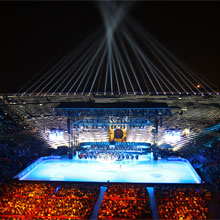 |
| The system includes EV XLD line-array elements, CP3000S and CP4000S power amps and DC-One, Dx46 controllers |
Sporting excellence and the high art of opera presented in a historic setting – such is the concept of “Opera on Ice” in the Arena di Verona. 2013’s show had an audience of 12,000 and was also enthusiastically attended by numerous celebrities - including Princess Caroline of Monaco and her son Pierre Casiraghi. All experienced an ice revue featuring some of the world’s biggest ice-skating stars (including Carolina Kostner and Evgeni Plushenko) as well as high-class opera singers such as Vittorio Grigolo and Elisa Balbo.
The sound production for the event was the responsibility of Backstage PA, a company based in Mariano Comense just north of Milan. An exciting task, for the 2,000-year-old amphitheater – the third largest such arena in the world – offers the ideal architectural conditions for evenly dispersed frontal sound reinforcement.
In addition to obtaining the right coverage pattern and the high sound pressure levels and differentiated frequency response required, compactness was a key criterion in the choice of loudspeakers. This was because Italian TV’s Canale 5 was recording the entire show for transmission on December 25, 2013.
“We wanted television viewers to see as little as possible of the enclosures, so they could not afford to be too large,” says Pino die Constanzo, the managing director of Backstage PA. For this reason, the client stipulated that the system must be powerful and yet compact.
Di Constanzo and his team opted therefore for systems from Electro-Voice. To find a solution capable of delivering homogeneous and yet discreet coverage, Backstage PA conducted exhaustive simulations in the historic amphitheater. The best solution, it emerged, was to divide the area to be covered into two zones. The main PA comprised two hangs of 16 Electro-Voice XLD line-array elements. Two additional hangs of 12 XLD enclosures each provided side fill to round off the acoustic provision for the audience area.
For the skating rink itself in front of the stage, a further eight Electro-Voice XLD enclosures provided down fill, whilst additional sound pressure in the low frequency range was supplied by Electro-Voice Xsubs. The array elements were powered by 18 Electro-Voice CP3000S amplifiers (driven by six Dx46 controllers), whilst four Electro-Voice CP4000S amplifiers (driven by two DC-One controllers) delivered the requisite power to the subwoofers.
After the show, Pino di Constanzo expressed himself highly satisfied with the choices he and his team had made. “The system operated flawlessly and exactly as we had envisioned,” he said. The sound specialist from northern Italy was particular taken with a number of details of the setup. “The factory presets supplied as standard with the controllers and the FIR filters for the XLDs, which we were able to download free of charge for IRIS-Net, made our work considerably easier. These are sensible and extremely useful features.”
With a prestige event such as “Opera on Ice”, the expectations of everyone involved are extremely high. For this reason, di Constanzo was particularly gratified by the positive feedback he received in the immediate aftermath of the gala. “Fabio Mastrangelo, the conductor of the 200-strong choir and orchestra, made a point of praising our work,” recalls di Constanzo.
Riccardo Barbaglios of Canale 5 also expressed his appreciation of the work of the Backstage PA team. “I would like to thank the team from Backstage for selecting such unobtrusive and yet powerful enclosures,” he said. “That made it possible for me to illuminate the stage in an ideal manner.”
Even the arena’s production manager, Paolo De Biasi, who was initially skeptical in view of the modest dimensions of the system, was immediately impressed by the performance of the Electro-Voice systems at the first rehearsal and intends from now on, according to di Constanzo, to rely on Electro-Voice sound reinforcement for similar events in the future.




